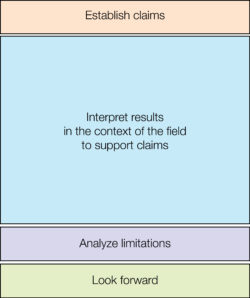Criteria for Success
A strong Discussion section:
- Establishes the main claim/conclusion of the paper in one or two sentences.
- Interprets how the paper’s results contribute to answering the big questions posed in the Introduction.
- Describes how (and why) this work supports or challenges other, similar work.
- Analyzes how the limitations of this study leave some questions unanswered.
- Looks forward & describes how this paper’s results/techniques can be extended to answer more pieces of the big questions.
Structure Diagram

Purpose
The Discussion is the part of your paper where you interpret your data to support your main claim/conclusion. Often, a big part of your claim will be how/why your results address the problems you identified in the introduction.
The Introduction and Discussion are natural partners: the Introduction tells the reader what question you are working on and why you did this experiment to investigate it; the Discussion guides the reader how to interpret the results, how they results relate to the field, and what the results have to say about the bigger questions you’re addressing.
Analyze your audience
Different kinds of readers will expect different things from your Discussion. Readers who are not expert in your field might read your Discussion before your Results in the hopes that they can learn what your Results mean and why your paper is important without having to learn how to interpret your experimental results. They might also be interested to know what you think the future of your field is. Readers who are more familiar with your field will generally understand what the results of your experiments say, but they will be curious about how you interpreted confusing, conflicting, or complicated results.
As you write your Discussion, decide who will find each paragraph interesting and what you want them to take away from it. Successful Discussions can simultaneously provide the specific, nuanced information that experts want to read and the broader, more general statements that non-experts can appreciate.
The balance between expert and non-expert readers will depend on the journal you submit to. High-profile, general readership journals will have more non-expert readers, while more technical, field-specific journals can have almost exclusively expert readers.
Skills
Interpret your results (analysis!)
Data rarely tells its own story. While your introduction and methods sections will set up what you are measuring and why, the Discussion section is your place to so “so what?” and break down what the numbers mean. Are your results expected? Surprising? Why? In what context? How does your data and interpretation relate to the understanding established by previous literature? Can you make new predictions? What do your results mean for the field moving forward?
Start with a strong claim
Weak Discussions begin with a summary of the results or a repetition of the main points of the Introduction. Strong Discussions immediately carve out a place for themselves in the large universe of papers by establishing what makes your results valuable in the context of the field they are in.
Place your results within the field
Relate your work/methods to the existing literature that you’ve drawn from: did you extend previous work? confirm theories? expose a new contradiction? rectify an old one? When it’s all said and done, your interpretations need to support your claim of what your research means for the big problem you’ve approached, and why it’s valuable within the body of existing literature.
Tell how your study’s limitations leave open the big questions
You can’t do everything, and sometimes you have to make an executive decision to approach a problem along one path (of experiments, analysis, interpretation…). How do those limitations restrict how you can apply your results? Do they leave some questions unresolved? Do you just need to do more of the same kind of work? Have you shown that current methods are inadequate to answering the big question?
Look forward
Every paper is a contribution to a larger scientific conversation. Maybe it provides new information or tools that will help researchers move toward answers to the big questions. Maybe it answers a big question, or contradicts an existing hypothesis. Many discussions will end with a forward looking interpretation of the research field: How can your results or techniques be built upon to identify, ask, or answer more questions?
